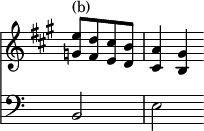three Semibreves; and the black one, to two only—

Again, the Perfection, or Imperfection, of any note whatever, could be regulated by means of a Point.
Imperfect notes were made Perfect by the Point of Augmentation—the exact equivalent to the dot in modern Music, and, therefore, needing no example.
Notes, Perfect by the Modal Sign, but rendered Imperfect, by position, could be restored to Perfection by a Point of Division, as in the next example, where the first Semibreve, equal, in the Greater Prolation, to three Minims, would be made Imperfect by the Minim which follows it, were it not for the Point of Division placed between the two notes—

In both these cases, the Point serves to augment the value of the notes: but, it may also be made to produce an exactly contrary effect. For instance, a Point of Division, placed between two shorter notes, following and preceding two longer ones, in Perfect Time, served, antiently, to render both the longer notes Imperfect. In the following example, therefore, the Breves are equal to two Semibreves only—

There are other ways in which the Perfection of certain notes may be changed to Imperfection, and vice versa; and, for these, the Student will do well to consult the pages of Zacconi, Zarlino, and Thomas Morley. [See Mode, Time, Prolation, Proportion, Point, Notation.]
II. Writers on Plain Chaunt apply the term, Imperfect, to Melodies which fail to extend throughout the entire compass of the Mode in which they are written. Thus, the melody of the Antiphon, Angelus autem Domini (see Antiphon), is in the Eighth Mode; but, as it only extends from F to D—two notes short of the full range of the Hypomixolydian scale—it is called an Imperfect Melody.
III. Imperfect Cadence or Half Close. Cadences occupy the position in music which stops do in literature, and of these the Perfect Cadence or full close answers to a full stop, and the Imperfect Cadence or half close to stops of less value. The former consists invariably of a progression towards and a pause upon the Tonic chord in its first position; the latter of a progression towards and a pause on some other chord than the chord of the Tonic in its first position. Both Cadences are to a certain degree dependant on the position they occupy in the group of bars or rhythms which constitute the period or phrase; for when the succession of chords which theoretically constitutes a cadence occurs in the middle of a continuous passage it has not any actual significance of the kind implied by a cadence, but only when it occurs at the end of a period or phrase of some sort. This point is more important to note in relation to the Imperfect than to the Perfect Cadence; since the latter, being absolutely final, is restricted both as to its penultimate and to its ultimate chord; but the former being final only relatively to an incomplete portion of the music, as a comma is to an incomplete portion of an entire sentence, admits of variety not only in its penultimate but also in its ultimate chord; the chief requisites being that the final chord shall be sufficiently clear in its relation to the Tonic and sufficiently simple in its construction to stand in a position of harmonical prominence, and be listened to without any strong craving in the mind for change or resolution; since the chord which comes last must inevitably have much stress laid upon it.
The simplest form of the Imperfect Cadence is an exact reversal of the Perfect Cadence, viz. the succession of Tonic and Dominant harmony, as (a), in the key of C. The Dominant chord is the one most commonly met with as the last in an Imperfect Cadence, but it is capable of being preceded by a great variety of chords other than that of the Tonic in its first position. It is extremely common to meet with the first inversion of the major or minor chord of the supertonic, and even, though more rarely, the first position of that chord, as (b)—


etc.
from 'Crudel perchè' in the second act of Figaro. It is also frequently preceded by the first inversion of the chord of the subdominant, both major and minor; and by its first position more rarely. The chord of the submediant does not often occur, but it has been tried, as by Carissimi, as follows

etc.
The chord of the augmented sixth is also not unfrequently found, as

